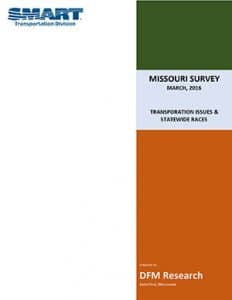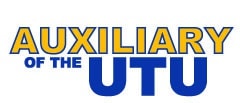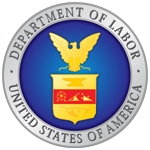 Reuters reported that the U.S. Supreme Court, in a 4-4 split decision, ruled in favor of public sector unions by preserving the legal precedent of agency fees, which are a vital source of cash for organized labor. Read the entire story here.
Reuters reported that the U.S. Supreme Court, in a 4-4 split decision, ruled in favor of public sector unions by preserving the legal precedent of agency fees, which are a vital source of cash for organized labor. Read the entire story here.
Author: amyr
 In their morning transportation tip sheet, POLITICO mentioned a poll recently conducted by DFM Research and SMART Transportation Division. The poll was conducted in Missouri and asked Missourians how they feel about issues in the transportation industry.
In their morning transportation tip sheet, POLITICO mentioned a poll recently conducted by DFM Research and SMART Transportation Division. The poll was conducted in Missouri and asked Missourians how they feel about issues in the transportation industry.
Click here to read the poll results.
Click here to read POLITICO’s write up (bottom of the page entitled, “Insights from the Show-Me State”).
Click here to read a statement by National Legislative Director John Risch.
A Canadian Pacific Engineer Trainee Jeffrey Harsh, was fatally injured early Sunday, in St. Paul, Minn.
“The Minnesota legislative board wishes the family of Mr. Harsh, members of locals 525 (Grand Forks, N.D.) and 911 (Minneapolis), our deepest condolences,” said Minnesota State Legislative Director Phil Qualy of the incident.
Services for Harsh will be held Sunday, April 3 at Schaff Funeral Home, 5920 W. Lincoln Ave., West Allis, WI 53219, from 4:30 p.m. through 8:00 p.m. Funeral services will be held at 9:00 a.m. on Monday, April 4 at the funeral home. Interment will follow at St. Adalbert’s Cemetery.
Click here to leave condolences for the family.

“Transit buses are a lifeline to opportunity for countless Americans, but too often these buses are outdated and unreliable,” said U.S. Transportation Secretary Anthony Foxx. “As demand for transit grows and our nation’s population continues to expand, these much-needed funds will help bring communities the latest technologies to strengthen and improve their bus infrastructure.”
Eligible projects include those that replace, rehabilitate, lease, and purchase buses and related equipment as well as projects to purchase, rehabilitate, construct or lease bus-related facilities, such as buildings for bus storage and maintenance.
“Our state and local partners across the country will benefit from the increased funding and flexibility available through this program,” said FTA Acting Administrator Therese McMillan. “With a large and growing maintenance backlog throughout the public transportation industry, it is vital for local agencies to have additional resources to address their community’s needs.”
FTA will award the grants to eligible transit agencies, state transportation departments, and Indian tribes on a competitive basis. Projects will be evaluated by criteria outlined in the Notice of Funding Opportunity, including the need for investment in bus transit systems, benefits to the community (including economic and workforce development), implementation of low and no-emission technologies, and integration with local and regional long-term planning.
Transportation contributes about 27 percent of U.S. greenhouse gas emissions, and the Administration has committed to major reductions in emissions. The FTA funds to help public transportation agencies purchase advanced technology, clean and efficient buses will help to reduce transportation emissions.
The Low-No Bus Program is a down payment on the administration’s 2017 budget proposal. Over a 10-year period, the “21st Century Clean Transportation Plan” invests an average of nearly $20 billion per year in new funds to reduce greenhouse gas emissions and provide new ways for families to get to work, to school, and to the store. The Budget would expand transit systems in cities, fast-growing suburbs, and rural areas; make high-speed rail a viable alternative to flying in major regional corridors; modernize our freight system; and expand the successful Transportation Investment Generating Economic Recovery (TIGER) program to support high-impact, innovative local projects.
The Fixing America’s Surface Transportation (FAST) Act, passed by Congress and signed into law by President Obama in December 2015, restored FTA’s competitive Bus & Bus Facilities Program, authorizing it through 2020. The FAST Act also made the Low-No program, previously funded and managed under FTA’s research programs, a subset of the larger competitive bus program.
The previous round of Low-No funding was announced in September 2015, and project selections are expected in the coming months.


The UTUIA offers two types of scholarships. The first scholarship is the UTUIA college scholarship for anyone attending college. Fifty scholarships of $2,000 each will be given out for each year that the student attends college for up to four years.
The second scholarship is the trade scholarship. This new scholarship is for students attending a two-year trade school. Fifty scholarships of $2,000 each will be given to 
Applicants must be at least a high school senior or equivalent and under the age of 26. Applicants must be associated with the UTUIA by either owning a UTUIA insurance policy, or by being the child or grandchild of a current UTUIA policyholder. Scholarship applicants must also be associated with the SMART Transportation Division by belonging to the union, or by being the child or grandchild of an active or lifetime SMART Transportation Division member.
Click here to read the official rules of the UTUIA’s scholarship program.
here to apply for either scholarship offered by the UTUIA online.

When applying for the scholarship, the Auxiliary member must have been a member for at least one year as of March 31 in the year of the scholarship application and must maintain membership throughout the duration of the scholarship award.
Click here for the official rules of the Auxiliary of the UTU Scholarship program. The official applicationappeared on page 5 of the Auxiliary’s December 2015 newsletter, located here.
WASHINGTON – The Occupational Safety and Health Administration (OSHA) has published a final rule that updates requirements for personal protective equipment for workers in general industry, shipyards, longshoring, marine terminals and construction.
The final rule reflects current national consensus standards, and ensures that workers can use up-to-date eye and face protection.
The rule updates references in OSHA’s Eye and Face Protection Standards to recognize the ANSI/ISEA Z87.1-2010, Occupational and Educational Personal Eye and Face Protection Devices, while deleting the outdated 1986 edition of that same national consensus standard. OSHA is also retaining the 2003 and 1989 (R-1998) versions of the ANSI standard already referenced in its standard.
Under the final rule, employers may follow any of the three latest versions of the Z87.1 standards. The new rule places no new obligations, costs or time constraints on employers. Employers that are already in compliance with OSHA’s eye and face requirements may continue their current practice in providing eye and face protection to their employees. The final rule now allows employers to follow the newest ANSI/ISEA Z87.1-2010 standard if they so choose.
Click here to read OSHA’s final rule in its entirety. For more information, visit OSHA’s website.

The U.S. Department of Labor announced yesterday that a new rule will require management to let workers know the source of anti-union messages. Corporations routinely utilize third-party consultants to develop and distribute anti-union messaging to workers who are considering forming a union, without disclosing to workers the source of the communications. Not any more. This rule mandates full messaging disclosure of any and all anti-union communications. Read the complete press release, here.

News Release
WASHINGTON – Many characterize union organizing campaigns as debates between management and labor over the impact of unionization on businesses and workers. Today, employers commonly engage third-party consultants in crafting and delivering anti-union messages to workers. Workers often do not know when employers engage consultants behind the scenes to influence their decisions. To address this lack of transparency, a new rule from the U.S. Department of Labor will require reporting of employer-consultant, or “persuader” agreements – to complement the information that unions already report on their organizing expenditures, resulting in better information for workers making decisions on whether or not to form a union or bargain collectively. “Workers should know who is behind an anti-union message. It’s a matter of basic fairness,” said U.S. Secretary of Labor Thomas E. Perez. “This new rule will allow workers to know whether the messages they’re hearing are coming directly from their employer or from a paid, third-party consultant. Full disclosure of persuader agreements gives workers the information they need to make informed choices about how they pursue their rights to organize and bargain collectively. As in all elections, more information means better decisions.” “This rule is about disclosure, and more disclosure here means more peaceful and stable labor-management relations. With workers having a better understanding of the true source of persuader communications, worker-supervisor and other workplace relationships are likely to proceed more smoothly no matter what is decided regarding union representation,” said Office of Labor-Management Standards Director Michael Hayes. The new rule interprets Section 203 of the Labor Management Reporting and Disclosure Act. The law requires labor organizations, consultants, and employers to file reports and disclose expenditures on labor-management activities. The law intends to prevent abuse, corruption, and improper practices by labor organizations, employers, and labor relations consultants alike. A longstanding loophole, however, allows employers to hire consultants to create materials, strategies and policies for organizing campaigns – and even to script managers’ communications with employees – without disclosing anything, as long as the consultant does not directly contact employees. The new rule closes the loophole to align the regulation with the statute, by requiring reporting on “actions, conduct or communications that are undertaken with an object, explicitly or implicitly, directly or indirectly, to affect an employee’s decisions regarding his or her representation or collective bargaining rights.” Under the same statute, unions already are required to make comprehensive public reports on their expenditures, including expenditures on union-organizing campaigns. The Federal Register will publish the new rule on March 24. The change will be applicable to arrangements, agreements, and payments made on or after July 1, 2016. The final rule and additional information is available on the OLMS website at http://www.dol.gov/olms/regs/compliance/ecr_finalrule.htm.